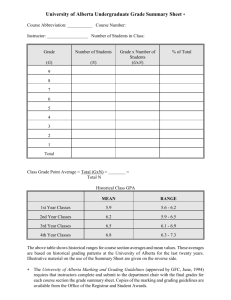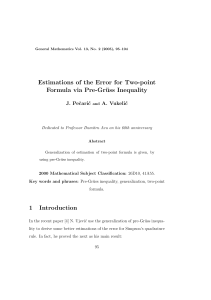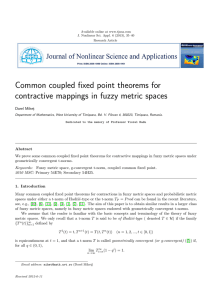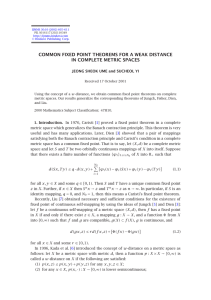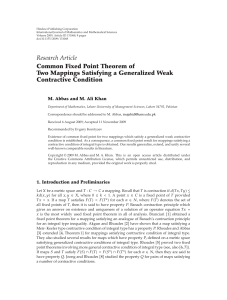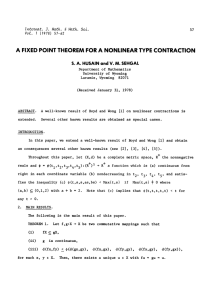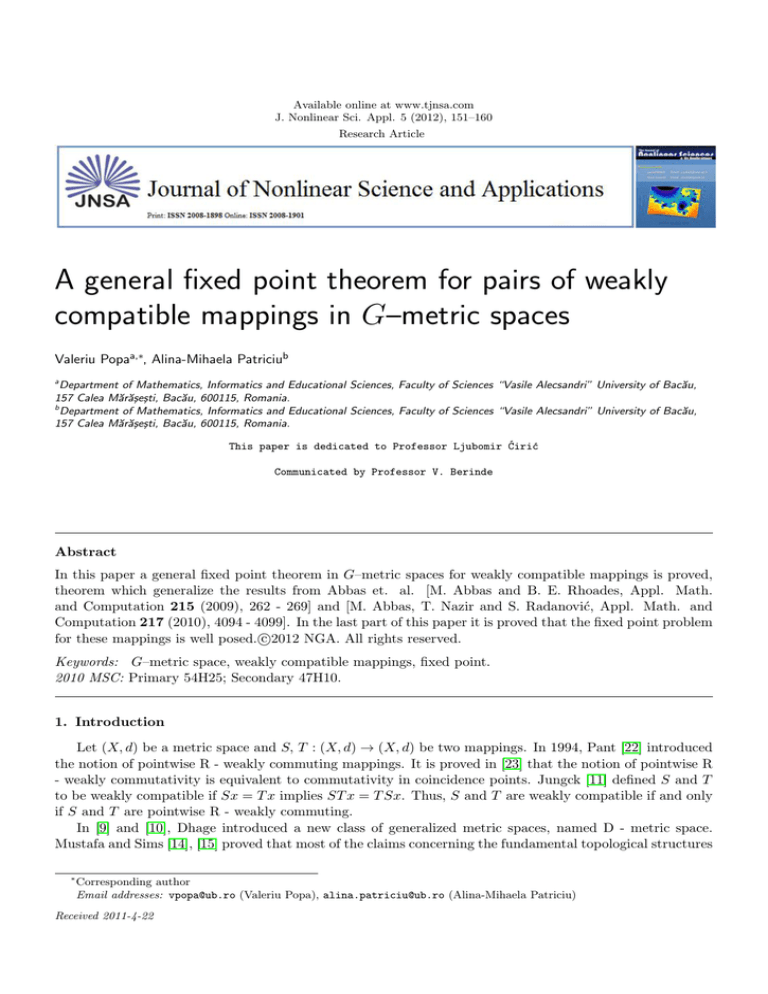
Available online at www.tjnsa.com
J. Nonlinear Sci. Appl. 5 (2012), 151–160
Research Article
A general fixed point theorem for pairs of weakly
compatible mappings in G–metric spaces
Valeriu Popaa,∗, Alina-Mihaela Patriciub
a
Department of Mathematics, Informatics and Educational Sciences, Faculty of Sciences “Vasile Alecsandri” University of Bacău,
157 Calea Mărăşeşti, Bacău, 600115, Romania.
b
Department of Mathematics, Informatics and Educational Sciences, Faculty of Sciences “Vasile Alecsandri” University of Bacău,
157 Calea Mărăşeşti, Bacău, 600115, Romania.
This paper is dedicated to Professor Ljubomir Ćirić
Communicated by Professor V. Berinde
Abstract
In this paper a general fixed point theorem in G–metric spaces for weakly compatible mappings is proved,
theorem which generalize the results from Abbas et. al. [M. Abbas and B. E. Rhoades, Appl. Math.
and Computation 215 (2009), 262 - 269] and [M. Abbas, T. Nazir and S. Radanović, Appl. Math. and
Computation 217 (2010), 4094 - 4099]. In the last part of this paper it is proved that the fixed point problem
c
for these mappings is well posed.2012
NGA. All rights reserved.
Keywords: G–metric space, weakly compatible mappings, fixed point.
2010 MSC: Primary 54H25; Secondary 47H10.
1. Introduction
Let (X, d) be a metric space and S, T : (X, d) → (X, d) be two mappings. In 1994, Pant [22] introduced
the notion of pointwise R - weakly commuting mappings. It is proved in [23] that the notion of pointwise R
- weakly commutativity is equivalent to commutativity in coincidence points. Jungck [11] defined S and T
to be weakly compatible if Sx = T x implies ST x = T Sx. Thus, S and T are weakly compatible if and only
if S and T are pointwise R - weakly commuting.
In [9] and [10], Dhage introduced a new class of generalized metric spaces, named D - metric space.
Mustafa and Sims [14], [15] proved that most of the claims concerning the fundamental topological structures
∗
Corresponding author
Email addresses: vpopa@ub.ro (Valeriu Popa), alina.patriciu@ub.ro (Alina-Mihaela Patriciu)
Received 2011-4-22
V. Popa, A.-M. Patriciu, J. Nonlinear Sci. Appl. 5 (2012), 151–160
152
on D - metric spaces are incorrect and introduced appropriate notion of generalized metric space, named G
- metric space. In fact, Mustafa, Sims and other authors studied many fixed point results for self mappings
in G - metric spaces under certain conditions [6], [16] - [21], [33] and other papers.
In [25] and [26], Popa initiated the study of fixed points for mappings satisfying implicit relations.
The notion of well posedness of a fixed point problem has generated much interest to several mathematicians, for example [8], [12], [24], [29], [30], [31]. Recently, Popa [27], [33] and Akkouchi and Popa [3], [4], [5]
studied well posedness problem for mappings satisfying implicit relations in metric spaces.
The purpose of this paper is to prove a general fixed point theorem in G - metric spaces for weakly
compatible pairs of mappings satisfying an implicit relation which generalize the results from [1] and [13].
In the last part of this paper we define the notion of a fixed point problem in G - metric spaces for two
mappings and we prove that in G - metric space with a G - symmetric, the fixed point problem is well posed.
2. Preliminaries
Definition 2.1 ([15]). Let X be a nonempty set and G : X 3 → R+ be a function satisfying the following
properties:
(G1 ) : G(x, y, z) = 0 if x = y = z,
(G2 ) : 0 < G(x, x, y) for all x, y ∈ X with x 6= y,
(G3 ) : G(x, x, y) ≤ G(x, y, z) for all x, y, z ∈ X with z 6= y,
(G4 ) : G(x, y, z) = G(x, z, y) = G(y, z, x) = ... (symmetry in all three variables),
(G5 ) : G(x, y, z) ≤ G(x, a, a) + G(a, y, z) for all x, y, z, a ∈ X.
Then the function G is called a G - metric on X and the pair (X, G) is called a G - metric space.
Note that G(x, y, z) = 0, then x = y = z.
Definition 2.2 ([15]). Let (X, G) be a metric space. A sequence (xn ) in X is said to be
a) G - convergent if for ε > 0, there is an x ∈ X and k ∈ N such that for all m, n ≥ k, G(x, xn , xm ) < ε.
b) G - Cauchy if for each ε > 0, there exists k ∈ N such that for all n, m, p ≥ k, G(xn , xm , xp ) < ε, that
is G(xn , xm , xp ) → 0 as m, n, n → ∞.
c) A G - metric space is said to be G - complete if every G - Cauchy sequence is G - convergent.
Lemma 2.3 ([15]). Let (X, G) be a G - metric space. Then, the following properties are equivalent:
1) (xn ) is G - convergent to x;
2) G(xn , xn , x) → 0 as n → ∞;
3) G(xn , x, x) → 0 as n → ∞;
4) G(xm , xn , x) → 0 as m, n → ∞.
Lemma 2.4 ([15]). If (X, G) is a G - metric space, the following are equivalent:
1) (xn ) is G - Cauchy.
2) For every ε > 0, there is k ∈ N such that G(xn , xm , xm ) < ε for all n, m ≥ k.
Definition 2.5 ([14]). Let (X, G) and (X 0 , G0 ) be two G - metric spaces. A function f : (X, G) → (X 0 , G0 )
is said to be G - continuous at a point x ∈ X if for ε > 0, there exists δ > 0 such that for all x, y ∈ X and
G(a, x, y) < δ, then G0 (f (a), f (x), f (y)) < ε.
A function f is G - continuous if f is G - continuous at each x ∈ X.
Lemma 2.6 ([15]). Let (X, G) and (X 0 , G0 ) be G - metric spaces. Then, a function f : (X, G) → (X 0 , G0 )
is G - continuous at a point x ∈ X if and only if it is G - sequentially continuous, that is, whenever (xn ) is
G - convergent to x, we have that f (xn ) is G - convergent to f (x).
Lemma 2.7 ([15]). Let (X, G) be a G - metric space, then the function G(x, y, z) is jointly continuous in
all three of its variables.
Definition 2.8 ([15]). A G - metric space (X, G) is called symmetric if G(x, y, y) = G(y, x, x, for all
x, y ∈ X.
Remark 2.9. There exists G - metric space which is not symmetric (Example 1 [15]).
V. Popa, A.-M. Patriciu, J. Nonlinear Sci. Appl. 5 (2012), 151–160
153
3. Implicit relations
Definition 3.1. Let FG be the set of all continuous functions F (t1 , ..., t6 ) : R6+ → R such that
(F1 ) : F is nonincreasing in variable t5 ,
(F2 ) : There exists h1 ∈ [0, 1) such that for all u, v ≥ 0, F (u, v, v, u, u + v, 0) ≤ 0 implies u ≤ h1 v.
(F3 ) : There exists h2 ∈ [0, 1) such that for all t, t0 > 0, F (t, t, 0, 0, t, t0 ) < 0 implies t ≤ h2 t0 .
Example 3.2. F (t1 , ..., t6 ) = t1 −at2 −bt3 −ct4 −dt5 −et6 , where a, b, c, d, e ≥ 0 and 0 < a+b+c+2d+e < 1.
(F1 ) : Obviously.
(F2 ) : Let u, v ≥ 0 be and F (u, v, v, u, u + v, 0) = u − av − bv − cu − d(u + v) ≤ 0. Then, u ≤ h1 v, where
a+b+d
0 ≤ h1 =
< 1.
1 − (c + d)
(F3 ) : Let t, t0 > 0 and F (t, t, 0, 0, t, t0 ) = t − at − dt − et0 ≤ 0. Then t ≤ h2 t0 , where 0 ≤ h2 =
e
< 1.
1 − (a + d)
1
.
Example 3.3. F (t1 , ..., t6 ) = t1 − k max{t2 , t3 , t4 , t5 , t6 }, where k ∈ 0,
2
(F1 ) : Obviously.
(F2 ) : Let u, v ≥ 0 be and F (u, v, v, u, u + v, 0) = u − k max{u, v, u + v} ≤ 0. Hence, u ≤ h1 v, where
k
0 ≤ h1 =
< 1.
1−k
(F3 ) : Let t, t0 > 0 and F (t, t, 0, 0, t, t0 ) = t − k max{t, t0 } ≤ 0. If t > t0 , then t(1 − k) ≤ 0, a contradiction.
Hence, t ≤ t0 which implies t ≤ h2 t0 , where 0 ≤ h2 = k < 1.
t5 + t6
Example 3.4. F (t1 , ..., t6 ) = t1 − k max t2 , t3 , t4 ,
, , where k ∈ [0, 1).
2
(F1 ) : Obviously.
u+v
(F2 ) : Let u, v ≥ 0 be and F (u, v, v, u, u+v, 0) = u−k max u, v,
≤ 0. If u > v, then u(1−k) ≤ 0,
2
a contradiction. Hence, u ≤ v which implies u ≤ h1 v, where
0 ≤ h01= k < 1.
t+t
≤ 0. If t > t0 , then t(1 − k) ≤ 0, a
(F3 ) : Let t, t0 > 0 and F (t, t, 0, 0, t, t0 ) = t − k max t,
2
contradiction. Hence, t ≤ t0 which implies t ≤ h2 t0 , where 0 ≤ h2 = k < 1.
Example 3.5. F (t1 , ..., t6 ) = t21 − t1 (at2 + bt3 + ct4 ) − dt5 t6 ≤ 0, where a, b, c, d ≥ 0 and 0 ≤ a + b + c + d < 1.
(F1 ) : Obviously.
(F2 ) : Let u, v ≥ 0 be and F (u, v, v, u, u+v, 0) = u2 −u(av+bv+cu) ≤ 0. If u > 0, then u−av−bv−cu ≤ 0
a+b
which implies u ≤ h1 v, where 0 ≤ h1 =
< 1. If u = 0 then u ≤ h1 v.
1−c
t3 + t4 t5 + t6
Example 3.6. F (t1 , ..., t6 ) = t1 − k max
,
, where k ∈ [0, 1).
2
2
(F1 ) : Obviously.
u+v
(F2 ) : Let u, v ≥ 0 be such that F (u, v, v, u, u + v, 0) = u − k max v,
≤ 0. If u > v, then
2
u(1 − k) ≤ 0, a contradiction. Hence, u≤ v which
implies u ≤ h1 v, where 0 ≤ h1 = k < 1.
0
t
+
t
≤ 0.If t > t0 then t(1 − k) ≤ 0, a contradiction. Hence
(F3 ) : F (t, t, 0, 0, t, t0 ) = t − k max t,
2
t ≤ t0 which implies t ≤ h2 t0 , where 0 ≤ h2 = k < 1.
Example 3.7. F (t1 , ..., t6 ) = t31 − c
(F1 ) : Obviously.
t23 t24 + t25 t26
, where c ∈ [0, 1).
1 + t2 + t3 + t4
V. Popa, A.-M. Patriciu, J. Nonlinear Sci. Appl. 5 (2012), 151–160
154
v 2 u2
v
≤ 0. If u > 0, then u ≤ cv
≤
1 + 2v + u
1 + 2v + u
cv. Hence, u ≤ h1 v, where 0 ≤ h1 = c < 1. If u = 0, then u ≤ h1 v.
t2 t02
t 02
(F3 ) : Let t, t0 > 0 be such that F (t, t, 0, 0, t, t0 ) = t3 − c
≤ 0, which implies t2 − c
t ≤ ct02 .
1
+
t
1
+
t
√
Hence t ≤ h2 t0 , where 0 ≤ h2 = c < 1. If u = 0 then u ≤ h1 v.
(F2 ) : Let u, v ≥ 0 be and F (u, v, v, u, u+v, 0) = u3 −c
Example 3.8. F (t1 , ..., t6 ) = t21 − at22 − b
t5 t6
, where a, b ≥ 0 and 0 ≤ a + b < 1.
1 + t23 + t24
(F1 ) : Obviously.
√
(F2 ) : Let u, v ≥ 0 be and F (u, v, v, u, u + v, 0) = u2 − av 2 ≤ 0. Hence, u ≤ h1 v, where 0 ≤ h1 = a < 1.
(F3 ) : Let t, t0 > 0 be and F (t, t, 0, 0, t, t0 ) = t2 − at2 − btt0 ≤ 0, which implies t ≤ h2 t0 , where 0 ≤ h2 =
b
< 1.
1−a
Example 3.9. F (t1 , ..., t6 ) = t1 − at2 − bt3 − c max{2t4 , t5 + t6 }, where a, b, c ≥ 0 and 0 ≤ a + b + 2c < 1.
(F1 ) : Obviously.
(F2 ) : Let u, v ≥ 0 be and F (u, v, v, u, u + v, 0) = u − av − c max{2u, u + v} ≤ 0. If u > v, then
a+b+c
< 1.
u(1 − (a + b + 2c)) ≤ 0, a contradiction. Hence, u ≤ v which implies u ≤ h1 v, where 0 ≤ h1 =
1−c
0
0
0
0
(F3 ) : Let t, t > 0 be and F (t, t, 0, 0, t, t ) = t − at − c(t + t ) ≤ 0, which implies t ≤ h2 t , where
c
0 ≤ h2 =
< 1.
1 − (a + c)
Example 3.10. F (t1 , ..., t6 ) = t1 − at2 − bt3 − c max{t4 + t5 , 2t6 }, where a, b, c ≥ 0 and 0 ≤ a + b + 3c < 1.
(F1 ) : Obviously.
(F2 ) : Let u, v ≥ 0 be and F (u, v, v, u, u + v, 0) = u − av − bv − c(2u + v) ≤ 0, which implies u ≤ h1 v,
a+b+c
where 0 ≤ h1 =
< 1.
1 − 2c
0
(F3 ) : Let t, t > 0 be and F (t, t, 0, 0, t, t0 ) = t − at − c max{t, 2t0 }. If t > 2t0 then t(1 − a − c) ≤ 0, a
2c
contradiction. Hence t ≤ 2t0 which implies t ≤ h2 t0 , where 0 ≤ h2 =
< 1.
1−a
√
√
Example 3.11. F (t1 , ..., t6 ) = t1 − c max{t2 , t3 , t4 t6 , t5 t6 }, where c ∈ [0, 1).
(F1 ) : Obviously.
(F2 ) : Let u, v ≥ 0 be such that F (u, v, v, u, u + v, 0) = u − cv ≤ 0, which implies u ≤ h1 v, where
0 ≤ h1 = c < 1.
√
(F3 ) : Let t, t0 > 0 be and F (t, t, 0, 0, t, t0 ) = t − c max{t, tt0 } ≤ 0. If t > t0 then t(1 − c) ≤ 0, a
contradiction. Hence t ≤ t0 which implies t ≤ h2 t0 , where 0 ≤ h2 = c < 1.
2t4 + t6 2t4 + t3 t5 + t6
Example 3.12. F (t1 , ..., t6 ) = t1 − k max t2 , t3 , t4 ,
,
,
, where k ∈ [0, 1).
3
3
3
(F1 ) : Obviously.
(F2 ) : Let u, v ≥ 0 be such that
2u 2u + v u + v
,
≤ 0.
F (u, v, v, u, u + v, 0) = u − k max u, v, ,
3
3
3
If u > v, then u(1 − k) ≤ 0, a contradiction. Hence u ≤ vwhich implies
u ≤ h1 v, where 0 ≤ h1 = k < 1.
0 t + t0
t
(F3 ) : Let t, t0 > 0 be and F (t, t, 0, 0, t, t0 ) = t − k max t, ,
. If t > t0 then t(1 − k) ≤ 0, a
3
3
contradiction. Hence t ≤ t0 which implies t ≤ h2 t0 , where 0 ≤ h2 = k < 1.
V. Popa, A.-M. Patriciu, J. Nonlinear Sci. Appl. 5 (2012), 151–160
155
4. General fixed point theorem
Definition 4.1. Let f and g be self maps of a nonempty set X. If w = f x = gx for some x ∈ X, then x is
called a coincidence point of f and g and w is called a point of coincidence of f and g.
Lemma 4.2 ([1]). Let f and g be weakly compatible self mappings of nonempty set X. If f and g have a
unique point of coincidence w = f x = gx, then w is the unique common fixed point of f and g.
Lemma 4.3. Let (X, G) be a G - metric space and f, g : (X, G) → (X, G) two functions such that
F (G(f x, f y, f y), G(gx, gy, gy), G(gx, f x, f x), G(gy, f y, f y),
G(gx, f y, f y), G(gy, f x, f x)) ≤ 0
(4.1)
for all x, y ∈ X and F satisfying property (F3 ). Then, f and g have at most a point of coincidence.
Proof. Suppose that u = f p = gp and v = f q = gq. Then by (4.1) we have
F (G(f q, f p, f p), G(gq, gp, gp), G(gq, f q, f q), G(gp, f p, f p),
G(gq, f p, f p), G(gp, f q, f q)) ≤ 0,
F (G(gq, gp, gp), G(gq, gp, gp), 0, 0, G(gq, gp, gp), G(gq, gp, gp)) ≤ 0
which implies by (F3 ) that
G(gq, gp, gp) ≤ h2 G(gp, gq, gq).
Similarly, we obtain that
G(gp, gq, gq) ≤ h2 G(gq, gp, gp)
which implies that G(gq, gp, gp)(1 − h22 ) ≤ 0. Hence G(gq, gp, gp) = 0, i.e. gq = gp. Therefore u = f p =
gp = gq = f q = v.
Theorem 4.4. Let (X, G) be a G - metric space and f, g : (X, G) → (X, G) satisfying inequality (4.1) for
all x, y ∈ X, where F ∈ FG . If f (X) ⊂ g(X) and g(X) is a G - complete metric subspace of (X, G), then f
and g have a unique point of coincidence. Moreover, if f and g are weakly compatible, then f and g have a
unique common fixed point.
Proof. Let x0 be an arbitrary point of X and x1 ∈ X such that f x0 = gx1 . This can be done since
f (X) ⊂ g(X). Continuing this process, having chosen xn in X, we obtain xn+1 such that f xn = gxn+1 .
Then, by (4.1) we have successively
F (G(f xn−1 , f xn , f xn ), G(gxn−1 , gxn , gxn ), G(gxn−1 , f xn−1 , f xn−1 ),
G(gxn , f xn , f xn ), G(gxn−1 , f xn , f xn ), G(gxn , f xn−1 , f xn−1 )) ≤ 0,
F (G(gxn , gxn+1 , gxn+1 ), G(gxn−1 , gxn , gxn ), G(gxn−1 , gxn , gxn ),
G(gxn , gxn+1 , gxn+1 ), G(gxn−1 , gxn+1 , gxn+1 ), 0) ≤ 0.
By (F1 ) and (G5 ) we obtain
F (G(gxn , gxn+1 , gxn+1 ), G(gxn−1 , gxn , gxn ), G(gxn−1 , gxn , gxn ),
G(gxn , gxn+1 , gxn+1 ), G(gxn−1 , gxn , gxn ) + G(gxn , gxn+1 , gxn+1 ), 0) ≤ 0.
By (F2 ) we obtain
G(gxn , gxn+1 , gxn+1 ) ≤ h1 G(gxn−1 , gxn , gxn )
(4.2)
Continuing the above process we obtain
G(gxn , gxn+1 , gxn+1 ) ≤ hn1 G(gx0 , gx1 , gx1 ).
(4.3)
V. Popa, A.-M. Patriciu, J. Nonlinear Sci. Appl. 5 (2012), 151–160
156
Then for m > n
G(gxn , gxm , gxm ) ≤ G(gxn , gxn+1 , gxn+1 ) + G(gxn+1 , gxn+2 , gxn+2 ) +
+... + G(gxm−1 , gxm , gxm )
≤ (hn1 + hn+1
+ ... + hm−1
)G(gx0 , gx1 , gx1 )
1
1
hn1
≤
G(gx0 , gx1 , gx1 )
1 − h1
which implies that G(gxn , gxm , gxm ) → 0 as n, m → ∞.
Hence, (gxn ) is a G - Cauchy sequence. Since g(X) is G - complete, there exists a point q in g(X) such
that gxn → q as n → ∞. Consequently, we can find a point p ∈ X such that gp = q. We prove that f p = gp.
By (4.1) we have successively
F (G(f xn−1 , gp, gp), G(gxn−1 , gp, gp), G(gxn−1 , f xn−1 , f xn−1 ),
G(gp, f p, f p), G(gxn−1 , f p, f p), G(gp, f xn−1 , f xn−1 )) ≤ 0,
F (G(gxn , f p, f p), G(gxn−1 , gp, gp), G(gxn−1 , gxn , gxn ),
G(gp, f p, f p), G(gxn−1 , f p, f p), G(gp, gxn , gxn )) ≤ 0.
Letting n tend to infinity, we obtain
F (G(gp, f p, f p), 0, 0, G(gp, f p, f p), G(gp, f p, f p), 0) ≤ 0.
By (F1 ) it follows that G(gp, f p, f p) = 0 which implies gp = f p. Hence w = f p = gp is a point of
coincidence of f and g. By Lemma 4.3, w is the unique point of coincidence. Moreover, if f and g are
weakly compatible, by Lemma 4.2, w is the unique common fixed point of f and g.
Remark 4.5. 1)
By Example 3.2 with d = e = 0 and Theorem 4.4 we obtain a partial result from
Theorem 2.3 [1].
2)
By Example 3.2 for b = c = d = e = 0 we obtain Theorem 2.1 [13].
3)
By Example 3.2 for b = c= 2 and Theorem 4.4 we obtain a partial result from Theorem 2.6 [1].
1
4)
By Example 3.3, for h ∈ 0,
we obtain a partial result of Theorems 2.4, 2.5 [1] which is a form
2
of Ciric result [7] in G - metric space.
5)
By Examples 3.4 - 3.12 we obtain new results.
5. Well posedness problem of fixed point for two mappings in G - metric spaces
Definition 5.1. Let (X, G) be a metric space and f : (X, d) → (X, d) be a mapping. The fixed point
problem f is said to be well posed [8] if
1)
f has a unique fixed point x0 ∈ X,
2)
for any sequence (xn ) ∈ X with limn→∞ d(xn , f xn ) = 0 we have
lim d(xn , x0 ) = 0.
n→∞
Definition 5.2. A function F : R6+ → R have property (Fp ) if for u, v, w ≥ 0 and F (u, v, 0, w, u, v) ≤ 0,
there exists p ∈ (0, 1) such that u ≤ p max{v, w}.
Example 5.3. F (t1 , ..., t6 ) = t1 − at2 − bt3 − ct4 − dt5 − et6 , as in Example 3.2.
Let u, v, w ≥ 0 be and F (u, v, 0, w, u, v) = u − av − cw − du − ev ≤ 0 which implies u ≤ p max{v, w},
a+c+e
where 0 < p =
< 1.
1−d
V. Popa, A.-M. Patriciu, J. Nonlinear Sci. Appl. 5 (2012), 151–160
157
1
Example 5.4. F (t1 , ..., t6 ) = t1 − k max{t2 , ..., t6 }, where k ∈ 0,
.
2
Let u, v, w ≥ 0 be and F (u, v, 0, w, u, v) = u − k max{v, w} ≤ 0. If u > max{v, w}, then u(1 − k) ≤ 0, a
contradiction. Hence u ≤ max{v, w} which implies u ≤ p max{v, w}, where 0 < p = k < 1.
t5 + t6
, where k ∈ [0, 1).
Example 5.5. F (t1 , ..., t6 ) = t1 − k max t2 , t3 , t4 ,
2
1
u+v
Let u, v, w ≥ 0 be and F (u, v, 0, w, u, v) = u−k max v, w, (u + v) . If u > max{v, w}, then u >
,
2
2
which implies u(1 − k) ≤ 0, a contradiction, hence u ≤ max{v, w} which implies u ≤ p max{v, w}, where
0 < p = k < 1.
Example 5.6. F (t1 , ..., t6 ) = t21 − t2 (at2 + bt3 + ct4 ) − dt5 t6 , where a, b, c, d ≥ 0 and 0 ≤ a + b + c + d < 1.
Let u, v, w ≥ 0 be and F (u, v, 0, w, u, v) = u2 − u(av + cw) − duv ≤ 0. If u > 0, then u ≤ p max{v, w},
where 0 ≤ p = a + c + d < 1. If u = 0, then u ≤ p max{v, w}.
t3 + t4 t5 + t6
Example 5.7. F (t1 , ..., t6 ) = t1 − k max t2 ,
, where k ∈ [0, 1).
,
2
2
w u+v
w u+v
Let u, v, w ≥ 0 be and F (u, v, 0, w, u, v) = u−k max v, ,
which implies u−k max v, ,
≤
2
2
2
2
0. If u > max{v, w}, then u(1 − k) ≤ 0, a contradiction. Hence u ≤ max{v, w} which implies u ≤
p max{v, w}, where 0 < p = k < 1.
t23 t24 + t25 t26
, where c ∈ [0, 1).
1 + t2 + t3 + t4
u2 v 2
v
Let u, v, w ≥ 0 be and F (u, v, 0, w, u, v) = u3 − c
≤ 0. If u > 0, then u ≤ cv
≤ cv ≤
1+v+w
1+v+w
p max{v, w}, where 0 < p = c < 1. If u = 0, then u ≤ p max{v, w}.
Example 5.8. F (t1 , ..., t6 ) = t31 − c
t5 t6
, where a > 0 and a + c < 1.
1 + t23 + t24
uv
Let u, v, w ≥ 0 be and F (u, v, 0, w, u, v) = u2 − c
≤ 0 which implies u2 − av 2 − cuv ≤ 0. Let v > 0,
1 + v2
u
then f (t) = t2 − ct − a , where t = . Then f (0) < 0 and f (1) > 0 and hence there exists p ∈ (0, 1) such
v
that f (t) ≤ 0 for t ≤ p. Hence u ≤ pv ≤ p max{v, w}. If v = 0, then u = 0 and u ≤ p max{v, w}.
Example 5.9. F (t1 , ..., t6 ) = t21 − at22 − c
Example 5.10. F (t1 , ..., t6 ) = t1 − at2 − c max {2t4 , t5 + t6 }, where 0 ≤ a + 2c < 1.
Let u, v, w ≥ 0 be and F (u, v, 0, w, u, v) = u−av −c max{2w, u+v}. If u > max{v, w} then u(1−a−2c) ≤ 0,
a contradiction. Hence u ≤ max{v, w} which implies u ≤ p max{v, w}, where 0 < p = a + 2c < 1.
Example 5.11. F (t1 , ..., t6 ) = t1 − at2 − bt3 − c max {t4 + t5 , 2t6 } ≤ 0, where 0 < p = a + 3c < 1. The proof
is similar to the proof of Example 5.8.
√
√
Example 5.12. F (t1 , ..., t6 ) = t1 − c max t2 , t3 , t4 t6 , t5 t6 , where c ∈ [0, 1).
√
√
Let u, v, w ≥ 0 be and F (u, v, 0, w, u, v) = u − c max{v, vw, uv} ≤ 0. If u > max{v, w} then
u(1 − c) ≤ 0, a contradiction. Hence u ≤ max{v, w} which implies u ≤ p max{v, w}, where 0 < p = c < 1.
2t4 + t6 2t4 + t5 t5 + t6
Example 5.13. F (t1 , ..., t6 ) = t1 − k max t2 , t3 , t4 ,
,
,
, where k ∈ [0, 1).
3
3
3
2w + v 2w u + v
,
,
≤ 0. If u > max{v, w}
Let u, v, w ≥ 0 be and F (u, v, 0, w, u, v) = u − k max v, w,
3
3
3
then u(1 − k) ≤ 0, a contradiction. Hence u ≤ max{v, w} which implies u ≤ p max{v, w}, where 0
< p = k < 1.
V. Popa, A.-M. Patriciu, J. Nonlinear Sci. Appl. 5 (2012), 151–160
158
Definition 5.14. Let (X, G) be a G - metric space and f, g : (X, G) → (X, G). The common fixed problem
of f and g is said to be well posed if:
1)
f and g have a unique common fixed point,
2)
for any sequence (xn ) in X with
lim G(xn , f xn , f xn ) = 0
n→∞
and
lim G(xn , gxn , gxn ) = 0,
n→∞
then
lim G(x, xn , xn ) = 0.
n→∞
Theorem 5.15. Let (X, G) be a symmetric G - metric space. For mappings f, g : (X, G) → (X, G) satisfying
Theorem 4.4 and F having property (Fp ), the fixed point problem of f and g is well posed.
Proof. By Theorem 4.4 f and g have a unique common fixed point x. Let (xn ) be a sequence in (X, G) such
that limn→∞ G(xn , f xn , f xn ) = 0 and limn→∞ G(xn , gxn , gxn ) = 0. By (4.1) we have successively
F (G(f x, f xn , f xn ), G(gx, gxn , gxn ), G(gx, f x, f x),
G(gxn , f xn , f xn ), G(gx, f xn , f xn ), G(gxn , f x, f x)) ≤ 0,
F (G(x, f xn , f xn ), G(x, gxn , gxn ), 0, G(gxn , f xn , f xn ),
G(x, f xn , f xn ), G(gxn , x, x)) ≤ 0.
Since G is a symmetric G - metric, G(gxn , x, x) = G(x, gxn , gxn ) and
F (G(x, f xn , f xn ), G(x, gxn , gxn ), 0, G(gxn , f xn , f xn ),
G(x, f xn , f xn ), G(x, gxn , gxn )) ≤ 0.
By (Fp ) we have
G(x, f xn , f xn ) ≤ p max{G(x, gxn , gxn ), G(gxn , f xn , f xn )}
≤ p(G(x, gxn , gxn ) + G(gxn , f xn , f xn )).
Then by (G5 ) and the fact that (X, G) is a symmetric G - metric space we have
G(x, xn , xn ) ≤ G(x, f xn , f xn ) + G(f xn , xn , xn )
≤ p(G(x, gxn , gxn ) + G(gxn , f xn , f xn )) + G(f xn , xn , xn )
≤ p(G(x, xn , xn ) + G(xn , gxn , gxn ) + G(gxn , xn , xn ) +
+G(xn , f xn , f xn )) + G(f xn , xn , xn )
= p(G(x, xn , xn ) + 2G(xn , gxn , gxn ) +
+G(xn , f xn , f xn )) + G(f xn , xn , xn ).
p+1
2p
G(xn , f xn , f xn ) +
G(xn , gxn , gxn ). Letting n tend to infinity we obtain
1−p
1−p
limn→∞ G(x, xn , xn ) = 0. Hence the common fixed point problem of f and g is well posed.
Hence G(x, xn , xn ) ≤
Remark 5.16. By Theorem 4.4 and Examples 5.3 - 5.13 we obtain new results.
Acknowledgements:
The authors thank the referee for the valuable comments and suggestions.
V. Popa, A.-M. Patriciu, J. Nonlinear Sci. Appl. 5 (2012), 151–160
159
References
[1] M. Abbas and B. E. Rhoades, Common fixed point results for noncommuting mappings without continuity in
generalized metric spaces, Appl. Math. and Computation 215 (2009), 262 - 269. 1, 4.5
[2] M. Abbas, T. Nazir and S. Radanović, Some periodic point results in generalized metric spaces, Appl. Math. and
Computation 217 (2010), 4094 - 4099.
[3] M. Akkouchi and V. Popa, Well posedness of common fixed point problem for three mappings under strict contractive conditions, Bull. Math. Inform. Physics, Petroleum - Gas Univ. Ploieşti 61, 2 (2009), 1 - 10. 1
[4] M. Akkouchi and V. Popa, Well posedness of a fixed point problem using G - function, Sc. St. Res. Univ. ”Vasile
Alecsandri” Bacău. Ser. Math. Inform. 20 (2010), 5 - 12. 1
[5] M. Akkouchi and V. Popa, Well posedness of fixed point problem for mappings satisfying an implicit relation,
Demonstratio Math. 43, 4 (2010), 923 - 929. 1
[6] R. Chung, T. Kadian, A. Rosie and B. E. Rhoades, Property (P) in G - metric spaces, Fixed Point Theory and
Applications 2010(2010) Article ID 401684, 12 pages. 1
[7] L. B. Ciric, A generalization of Banach contractions, Proc. Amer. Math. 45 (1974), 267 - 273. 4.5
[8] F. S. De Blassi et J. Myjak, Sur la porosite de contractions sans point fixe, Comptes Rend. Acad. Sci. Paris 308
(1989), 51 - 54. 1, 5.1
[9] B. C. Dhage, Generalized metric spaces and mappings with fixed point, Bull. Calcutta Math. Soc. 84(1992), 329
- 336. 1
[10] B. C. Dhage, Generalized metric spaces and topological structures I, Anal. St. Univ. Al. I. Cuza, Iasi Ser. Mat.
46, 1(2000), 3 - 24. 1
[11] G. Jungck, Common fixed points for noncontinuous, nonself maps on nonnumeric spaces, Far East J. Math. Sci.
4(2)(1996), 195-215. 1
[12] B. K. Lahiri and P. Das, Well posedness and porosity of certain classes of operators, Demonstratio Math. 38
(2005), 170 - 176. 1
[13] S. Manro, S. S. Bahtia and S. Kumar, Expansion mappings theorems in G - metric spaces, Intern. J. Contemp.
Math. Sci. 5(2010), no. 51, 2529 - 2535. 1, 4.5
[14] Z. Mustafa and B. Sims, Some remarks concerning D - metric spaces, Intern. Conf. Fixed Point. Theory and
Applications, Yokohama, 2004, 189 - 198. 1
[15] Z. Mustafa and B. Sims, A new approach to generalized metric spaces, J. Nonlinear Convex Analysis 7(2006),
289 - 297. 1, 2.9
[16] Z. Mustafa, H. Obiedat and F. Awadeh, Some fixed point theorems for mappings on G - complete metric spaces,
Fixed Point Theory and Applications 2008(2008) Article ID 189870, 12 pages. 1
[17] Z. Mustafa, W. Shatanawi and M. Bataineh, Fixed point theorem on uncomplete G - metric spaces, J. Math.
Statistics 4(4)(2008), 196 - 201.
[18] Z. Mustafa and B. Sims, Fixed point theorems for contractive mappings in complete G - metric spaces, Fixed
Point Theory and Applications, 2009(2009) Article ID 917175, 10 pages.
[19] Z. Mustafa, W. S. Shatanawi and M. Bataineh, Existence of fixed point results in G - metric spaces, Intern. J.
Math. Math. Sci. 2009(2009) Article ID 283028, 10 pages.
[20] Z. Mustafa and H. Obiedat, A fixed point theorem of Reich in G - metric spaces, Cuba A. Math. J. 12(2010), 83
- 93.
[21] H. Obiedat and Z. Mustafa, Fixed results on a nonsymmetric G - metric spaces, Jordan. J. Math. Statistics
3(2)(2010), 65 - 79. 1
[22] R. P. Pant, Common fixed point for noncommuting mappings, J. Math. And Appl. 188(1994), 436 - 440. 1
[23] R. P. Pant, Common fixed point for four mappings, Bull. Calcutta Math. Soc. 9(1998), 281 - 286. 1
[24] A. Petruşel, I. A. Rus, J. C. Yao, Well-posedness in the generalized sense of the fixed point problems for multivalued
operators, Taiwanese J.Math. 11, 3(2007), 903 - 912. 1
[25] V. Popa, Fixed point theorems for implicit contractive mappings, Stud. Cerc. St. Ser. Mat., Univ. Bacău 7(1997),
129 - 133. 1
[26] V. Popa, Some fixed point theorems for compatible mappings satisfying implicit relations, Demonstratio Math.
32, 1(1999), 157 - 163. 1
[27] V. Popa, Well posedness of fixed problem in orbitally complete metric spaces, Stud. Cerc. St. Ser. Math. Univ.
Bacău 16 (2006), Suppl., 209 – 214. 1
[28] V. Popa, Well posedness of fixed point problem in compact metric spaces, Bull. Math. Inform. Physics Series,
Petroleum - Gas Univ. Ploieşti 60, 1 (2008), 1 - 4.
[29] S. Reich and A. J. Zaslavski, Well posedness of fixed point problems, Far East J. Math. Sci. Special volume, Part.
III (2001), 393 - 401. 1
[30] I. A. Rus, Generalized contractions and applications, Cluj University Press, Cluj-Napoca, 2008. 1
[31] I. A. Rus, Picard operators and well-posedness of fixed point problems, Studia Univ. “Babeş - Bolyai”, Mathematica
52, 3(2007), 147 - 156. 1
[32] I. A. Rus, A. Petruşel, G. Petruşel, Fixed Point Theory, Cluj University Press, Cluj Napoca, 2008.
V. Popa, A.-M. Patriciu, J. Nonlinear Sci. Appl. 5 (2012), 151–160
160
[33] W. Shatanawi, Fixed point theory for contractive mappings satisfying Φ - maps in G - metric spaces, Fixed Point
Theory and Applications, 2010(2010) Article ID 181650, 9 pages.


